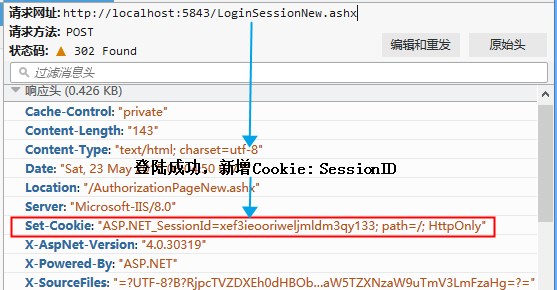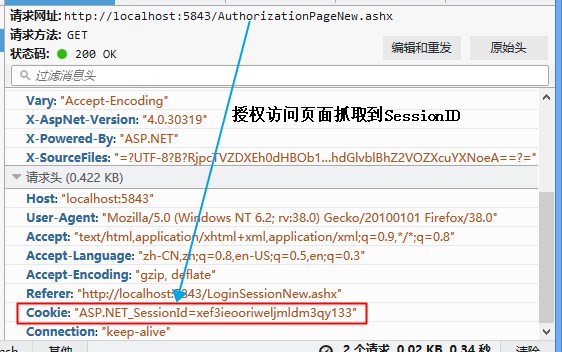1,HTTP协议是无状态的。服务器不会记住上次给浏览器的处理结果,如果需要上次处理结果(上次状态)就需要浏览器把处理结果值(上次状态)再次给服务器。
2,URL传值:通过URL参数或者通过Form表单进行页面件的传值 (不能做到很自由的存取和读取,而且不安全)
3,Cookie :①Cookie可以用来进行更加自由的数据的存取和读取。
②Cookie是和站点相关的,自己域名写的只有自己的域名才可以读取。
③客户端向服务器发送请求的时候 处理发送Form表单信息以外还会把和站点有关的所有的Cookie发送给服务器,是强制的。
④服务器返回的数据处理HTML数据以外,还会返回修改的Cookie,浏览器拿到修改后的Cookie更新到本地的Cookie
⑤服务器端使用Cookie案例,记住用户名功能:
A,设置页面值: Response.SetCookie(new HttpCookie("UserName",username))
B,读取页面值: username=Request.Cookies["UserName"].Value
⑥浏览器关闭以后Cookie的声明周期到期,也就是Cookie的默认生命周期是浏览器的生命周期。可以通过设置Expires属性设置Cookie的过期时间:Cookie.Expires=DateTime.Now.AddDays(-1)
⑦Cookie在客户端是以键值对存在的
4,Cookie缺点:①客户端额可以手动清楚Cookie 所以Cookie里面存放的信息是可有可无的信息
②浏览器对 Cookie 的大小有限制,因此只有不超过 4096 字节才能保证被接受
③机密信息不能放到Cookie里面
④Cookie不能跨浏览器
5,Cookie的写和读: A,新建CookieTest.html页面并添加 两个按钮分别用于Cookie的读和写

<!DOCTYPE html> <html xmlns="http://www.w3.org/1999/xhtml"> <head> <meta http-equiv="Content-Type" content="text/html; charset=utf-8" /> <title></title> </head> <body> <form> <input type="submit" name="Read" value="读取Cookie" /> <input type="submit" name="Write" value="写入Cookie" /> <br /> 读取出来的Cookie: $Model.CookieValue </form> </body> </html>
B,建立对应的CookieTest.ashx页面 实现Cookie的新建写入本地以及读取Cookie的值

using System; using System.Collections.Generic; using System.Linq; using System.Web; namespace HttpNoStatus { /// <summary> /// HttpCookie 的摘要说明 /// </summary> public class CookieTest : IHttpHandler { public void ProcessRequest(HttpContext context) { context.Response.ContentType = "text/html"; //if else 判断是点击的那个按钮 if (!string.IsNullOrEmpty(context.Request["Read"])) { if (context.Request.Cookies["Age"] != null) { HttpCookie cookie = context.Request.Cookies["Age"]; string strValue = cookie.Value; var data = new { CookieValue = strValue }; //加载模板页面并传递 Cookie Value的值 string strHtml = Common_Nvelocity.RenderHTML("CookieTest.html", data); context.Response.Write(strHtml); } else { context.Response.Write("cookie 不存在"); } } else if (!string.IsNullOrEmpty(context.Request["Write"])) { //写入新的Cookie HttpCookie acookie = new HttpCookie("Age"); acookie.Value = "25"; acookie.Expires = DateTime.MaxValue; context.Response.Cookies.Add(acookie); //Cookie不存在 直接加载模板页面 string strHtml = Common_Nvelocity.RenderHTML("CookieTest.html", null); context.Response.Write(strHtml); } else { //第一次加载页面 string strHtml = Common_Nvelocity.RenderHTML("CookieTest.html", null); context.Response.Write(strHtml); } } public bool IsReusable { get { return false; } } } }
6,Cookie最主要的一个功能是保存用户的登陆名,这样用户在下次登陆的时候系统就可以自动填写登陆名称
A,新建LoginCookie.html页面,页面中添加我们经常见到的 用户名,用户密码,登陆
登陆页面第一次加载的时候,设置默认的登陆名为空,登陆成功以及再次登陆的时候系统就自动补充登陆用户名

<!DOCTYPE html> <html xmlns="http://www.w3.org/1999/xhtml"> <head> <meta http-equiv="Content-Type" content="text/html; charset=utf-8" /> <title></title> </head> <body> <form action="LoginCookie.ashx" method="post"> <table> <tr> <td>登陆名</td> <td> <input type="text" name="UserName" value="$Model.LoginUser" /></td> </tr> <tr> <td>密码</td> <td> <input type="password" name="Password" /></td> </tr> <tr> <td> <input type="submit" name="Login" value="登陆" /></td> <td></td> </tr> </table> </form> </body> </html>
B, 新建对应的LoginCookie.ashx页面,实现把用户名读取出来并写入Cookie "ckLoginUser"

using System; using System.Collections.Generic; using System.Linq; using System.Web; namespace HttpNoStatus { /// <summary> /// LoginCookie 的摘要说明 /// </summary> public class LoginCookie : IHttpHandler { public void ProcessRequest(HttpContext context) { context.Response.ContentType = "text/html"; //加载页面直接显示 页面 if (context.Request.Form["Login"] == null) { string strHtml = ""; var data = new { LoginUser = "" }; //登陆账号默认为空 //判断Cookie是否存在,如果存在 把Cookie的值传递到HTML页面,如果不存在就是默认的空 if (context.Request.Cookies["ckLoginUser"] != null) { data = new { LoginUser = context.Request.Cookies["ckLoginUser"].Value.ToString() }; } strHtml = Common_Nvelocity.RenderHTML("LoginCookie.html", data); context.Response.Write(strHtml); } else { //用户登陆,保存用户名到Cookie HttpCookie LoginUser = new HttpCookie("ckLoginUser"); LoginUser.Value = context.Request.Form["UserName"]; LoginUser.Expires = DateTime.Now.AddDays(30); context.Response.Cookies.Add(LoginUser); //加载页面直接显示 页面 string strHtml = Common_Nvelocity.RenderHTML("LoginCookie.html", new { LoginUser = context.Request.Form["UserName"] }); context.Response.Write(strHtml); } } public bool IsReusable { get { return false; } } } }
7,以上方法把登陆账号以Cookie的形式存放在客户端,这样每一次的请求就可以带出用户登陆名称了
有一种情况: 用户登陆成功以后就可以访问网站的其他所有页面,其他页面就需要先判断用户是否登陆成功。
如果登陆成功为True放到Cookie中,这样的客户端就可以进行篡改把False改为True从而可以非法访问为授权页面了,这样放到Cookie就不安全了。
如果登陆成功放到服务器端,那么网站的多个页面就可以直接读取到这个值,而且是安全的不会被客户端篡改的了。
8,Session原理: 把数据Value值存储在服务器端并在客户端存放Value对应的ID 。(ID,Value)都存放服务器 另外把ID以Cookie的形式存放客户端。这样就可以从客户端Cookie中抓取ID,然后从服务器端读取到ID对应的Value。
10,下面示例以Session原理实现页面判断用户是否有成功登陆:成功登陆的用户可以对特定页面进行访问、如果没有成功登陆就跳转到登陆页面。
A. 添加类 SessionMgr.cs 在服务器端存储 键值对 ID/Value

using System; using System.Collections.Generic; using System.Linq; using System.Web; namespace HttpNoStatus { public class SessionMgr { //定义键值对,存储登陆信息 private static Dictionary<Guid, string> KeyValue = new Dictionary<Guid, string>(); //设置键值对的值 public static void SetKeyValue(Guid id, string value) { KeyValue[id] = value; } /// <summary> /// 检查客户端传递过来的键值对是否存在 /// </summary> /// <param name="id"></param> /// <returns></returns> public static bool IfIdExist(Guid id) { return KeyValue.Keys.Contains(id); } //返回服务器端ID对应的Value值 public static string GetValue(Guid id) { return KeyValue[id].ToString(); } } }
B. 添加 LoginSession.ashx 判断用户是否登陆成功,如果登陆成功把存储对应的键值对的值

using System; using System.Collections.Generic; using System.Linq; using System.Web; namespace HttpNoStatus { /// <summary> /// LoginSession 的摘要说明 /// </summary> public class LoginSession : IHttpHandler { public void ProcessRequest(HttpContext context) { context.Response.ContentType = "text/html"; string strHtml = ""; //读取用户名和密码 string strUserName = context.Request.Form["txtUserName"]; string strPwd = context.Request.Form["txtPassword"]; if (strPwd == "123456") { //登陆成功,设置对应的键值对 Guid id = Guid.NewGuid(); // 产生唯一的ID SessionMgr.SetKeyValue(id, strUserName); //id 保存在客户端cookie中 HttpCookie loginCookie = new HttpCookie("LoginCookie"); loginCookie.Value = id.ToString(); loginCookie.Expires = DateTime.Now.AddDays(7); context.Response.Cookies.Add(loginCookie); //跳转到授权页面 context.Response.Redirect("AuthorizationPage.ashx"); } else { //登陆失败 , 加载登陆页面 strHtml = Common_Nvelocity.RenderHTML("LoginSession.html", null); context.Response.Write(strHtml); } } public bool IsReusable { get { return false; } } } }
C. Templates文件夹下添加LoginSession.html 登陆页面

<!DOCTYPE html> <html xmlns="http://www.w3.org/1999/xhtml"> <head> <meta http-equiv="Content-Type" content="text/html; charset=utf-8" /> <title></title> </head> <body> <form action="LoginSession.ashx" method="post"> <table> <tr> <td>登陆名</td> <td> <input type="text" name="txtUserName" /></td> </tr> <tr> <td>密码</td> <td> <input type="password" name="txtPassword" /></td> </tr> <tr> <td> <input type="submit" name="Login" value="登陆" /></td> <td></td> </tr> </table> </form> </body> </html>
D. 添加AuthorizationPage.ashx页面,只有登陆后的账户才有权限访问这个页面

using System; using System.Collections.Generic; using System.Linq; using System.Web; namespace HttpNoStatus.Templates { /// <summary> /// AuthorizationPage 的摘要说明 /// </summary> public class AuthorizationPage : IHttpHandler { public void ProcessRequest(HttpContext context) { context.Response.ContentType = "text/html"; //抓取客户端 Cookie的ID值 HttpCookie loginCookie = context.Request.Cookies["LoginCookie"]; if (loginCookie != null) { Guid id = new Guid(loginCookie.Value); // 读取id对应的Value string strValue = SessionMgr.GetValue(id); //输出Value值,并提示该账号是已经登陆的账号 context.Response.Write(strValue + ",您已经登陆本网站,有权限访问此页面"); } //如果Cookie不存在,则直接跳转到登页面 else { context.Response.Redirect("LoginSession.ashx"); } } public bool IsReusable { get { return false; } } } }
------------------------------------------------------------gif动画演示----------------------------------------------------------------

11,上面的示例是也就是Session原理。Asp.net已经内置了Session机制,下面我们直接用ASP.NET Session实现 判断用户是否有登陆成功:
(一般处理程序HttpHandler操作Session, 要实现IRequiresSessionState接口)
分别添加页面: LoginSessionNew.ashx(登陆一般处理程序) , LoginSessionNew.html(登陆模板), AuthorizationPageNew.ashx(登陆后才有权限访问的页面)。
A,LoginSessionNew.ashx(登陆一般处理程序)

using System; using System.Collections.Generic; using System.Linq; using System.Web; using System.Web.SessionState; namespace HttpNoStatus { /// <summary> /// LoginSessionNew 的摘要说明 /// </summary> public class LoginSessionNew : IHttpHandler, IRequiresSessionState { public void ProcessRequest(HttpContext context) { context.Response.ContentType = "text/html"; string strHtml = ""; //读取用户名和密码 string strUserName = context.Request.Form["txtUserName"]; string strPwd = context.Request.Form["txtPassword"]; if (strPwd == "123456") { //登陆成功,直接保存Session值 context.Session["LoginUserName"] = strUserName; //跳转到授权页面 context.Response.Redirect("AuthorizationPageNew.ashx"); } else { //登陆失败 , 加载登陆页面 strHtml = Common_Nvelocity.RenderHTML("LoginSessionNew.html", null); context.Response.Write(strHtml); } } public bool IsReusable { get { return false; } } } }
B,Templates模板下新建LoginSessionNew.html(登陆模板)

<!DOCTYPE html> <html xmlns="http://www.w3.org/1999/xhtml"> <head> <meta http-equiv="Content-Type" content="text/html; charset=utf-8" /> <title></title> </head> <body> <form action="LoginSessionNew.ashx" method="post"> <table> <tr> <td>登陆名</td> <td> <input type="text" name="txtUserName" /></td> </tr> <tr> <td>密码</td> <td> <input type="password" name="txtPassword" /></td> </tr> <tr> <td> <input type="submit" name="Login" value="登陆" /></td> <td></td> </tr> </table> </form> </body> </html>
C,AuthorizationPageNew.ashx(登陆后才有权限访问的页面)

using System; using System.Collections.Generic; using System.Linq; using System.Web; using System.Web.SessionState; namespace HttpNoStatus { /// <summary> /// AuthorizationPageNew 的摘要说明 /// </summary> public class AuthorizationPageNew : IHttpHandler, IRequiresSessionState { public void ProcessRequest(HttpContext context) { context.Response.ContentType = "text/plain"; //检查Session是否存在 object obj = context.Session["LoginUserName"]; if (obj != null) { //Session存在,读取Session值,并提示该账号是已经登陆的账号 context.Response.Write(obj.ToString() + ",您已经登陆本网站,有权限访问此页面"); } //如果Session不存在,则直接跳转到登页面 else { context.Response.Redirect("LoginSessionNew.ashx"); } } public bool IsReusable { get { return false; } } } }
· ASP.NET内置Session机制同样实现了对用户是否登陆成功的判断:LoginSessionNew.ashx页面Headers中我们看到了Cookie中多了ASP.NET_SessionId
Session机制在客户端存放了ASP.NET_SessionID

· 权限访问页面,请求头中读取到了客户端Cookie中的ASP.NET_SessionID

12, ASP.NET的Session机制: Session依赖于Cookie , 借助Cookie在客户端浏览器中记录了ID, 在服务器端存储了Value值。
13,Session的值是放到了服务器内存中,所以Session存放小数据。
Session(会话)有自动销毁机制,如果一段时间内浏览器没有和服务器交互,则Session会定时自动销毁。
登陆账号后,一段时间内如果不操作 系统就会自动退出,这就是Session自动销毁了。
